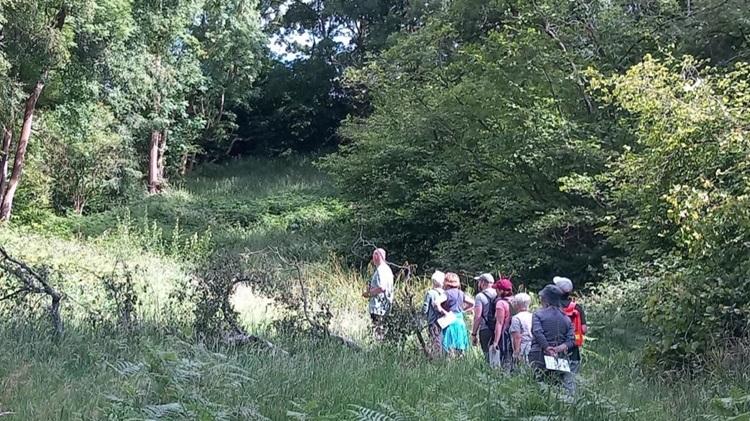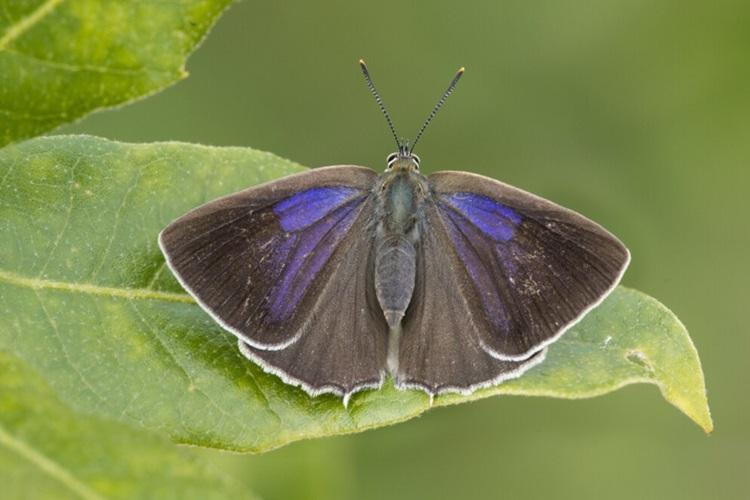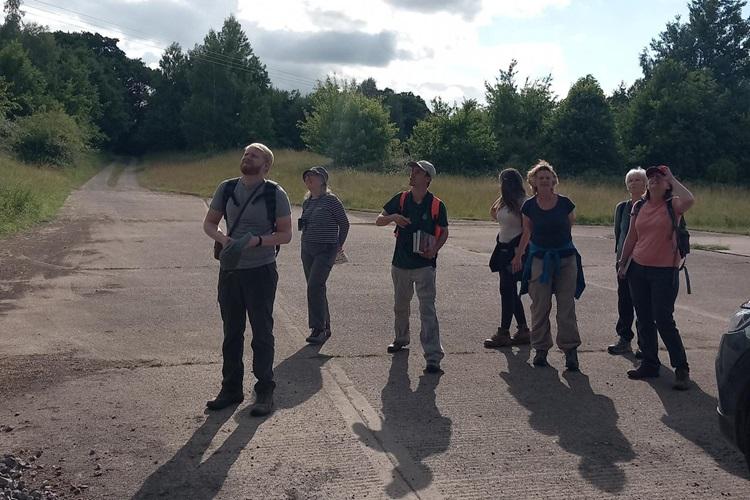
Arboreal Butterfly Survey Training
At the end of June, Mike Slater from Butterfly Conservation Warwickshire and Sam Macvie from the Heart of England Forest Biodiversity team, led a session around Alne Wood Park, focused on surveying for arboreal butterflies. These are species typically living around the canopies of trees rather than at shrub or ground level and as a consequence present specific challenges for observation.
At the end of June, Mike Slater from Butterfly Conservation Warwickshire and Sam Macvie from the Heart of England Forest Biodiversity team, led a session around Alne Wood Park, focused on surveying for arboreal butterflies. These are species typically living around the canopies of trees rather than at shrub or ground level and as a consequence present specific challenges for observation. The focus of the session was three species; white letter hairstreak, purple hairstreak and purple emperor.
A group of keen, Heart of England Forest volunteers, members of our biodiversity and forestry teams and myself met in the car park of the burial ground at around 3:30pm on a pleasant Friday afternoon, unusually for 2024 rain was not in the forecast.
Mike and Sam gave us an overview of what we were going to do and explained how surveying arboreal butterflies differs from the typical transect survey method. Rather than walking a route and observing species in a corridor of habitat, for arboreal butterflies you spend time observing a single site for a 10-minute window, identifying how many individuals of a specific species are occupying it. The first stage of this is choosing a suitable site as each species has preferences that dictate where you are most likely to see them.
The white letter hairstreak breeds on elm trees, Mike had previously identified a suitable tree just inside the woodland, close to the gate at the eastern end of the burial ground. As we watched the canopy of this particular tree, we were very soon treated to what appeared to be around 4 or 5 individual white letter hairstreaks fluttering in and out the leaves at the top. Mike explained how the different levels of sun, cloud and wind will influence their behaviour and understanding this can help increase your likelihood of a successful sighting.
Mike then also observed a very similar looking pair of butterflies in the upper reaches of a nearby oak. These he said were purple hairstreak, indicated firstly by the fact it was not an elm and secondly that in the sunlight they have a silvery sheen to them, rather than the brown tinge of the white letter hairstreaks. Making our way a bit further into Alne Wood we added another couple of purple hairstreaks to our tally in a different stand of oaks. From here we moved up the hill towards the back of the woods to look for the last of our three species.
Purple emperor are one of the largest butterflies in the UK, with the male having a spectacular, almost iridescent purple colouring on the topside of their wings. Once a butterfly restricted to the south of Britain, they are now being found in larger numbers partly due to improvement in suitable habitat, a better understanding of where and how to look for them, and the species quick and continuous expansion north and westward. Sam explained the best chance of seeing them would be in July around mid-afternoon (2-4pm) on a warm, sunny day without too much wind. In these conditions, the males like to use the canopy of oaks to create territories, trying to find a mate but otherwise fighting with anything that violates their airspace. Compared to the hairstreaks they tend to glide more rather than flutter and are much larger, so relatively easy to differentiate, even from a distance. Depending on wind direction they will prefer to be on the leeward side of the tree, or in depressions in the canopy in the liminal areas between groups of oaks. Despite looking in a few different areas where they have been known to frequent in previous years, we did not spot any, hindered by the cloud and being early in the season for them to be ‘on the wing’. Although while looking, we did see two more purple hairstreaks in the oaks just to the side of entrance to the burial ground.
All-in-all, it was fascinating to spend a couple of hours with Mike and Sam learning how to spot and differentiate these elusive canopy dwellers. Some key take-aways were to firstly know what would make a typical territory for each species and also the weather conditions that suit the butterflies taking to the air. Secondly, when observing a tree with the right characteristics, use your naked eye to notice movement first, then if you have binoculars you can take a closer look and may even be lucky enough to see a butterfly at rest to make a definitive ID. Lastly, patience is key, these butterflies are tricky to spot due to the distance they are typically being observed at, so you need to set yourself a 10 minute window to keep looking, then with a bit of knowledge and slice of luck you may get to see these interesting butterflies which most people will never realise are even there.
One thing I found interesting was how specific the habitat requirements are for each of these species to flourish. For example, the purple emperor prefer sallow trees such as the goat willow to lay their eggs on and then once mature they like to feed on the sap of old oaks. At Alne Wood Park we are fortunate to have an abundance of this combination, along with hard-the to-find elms the white letter hairstreak needs for successful breeding. These habitats are maintained and encouraged through the work of the Heart of England Forest, the charity who own the burial ground and benefit from any profit generated by the site.





